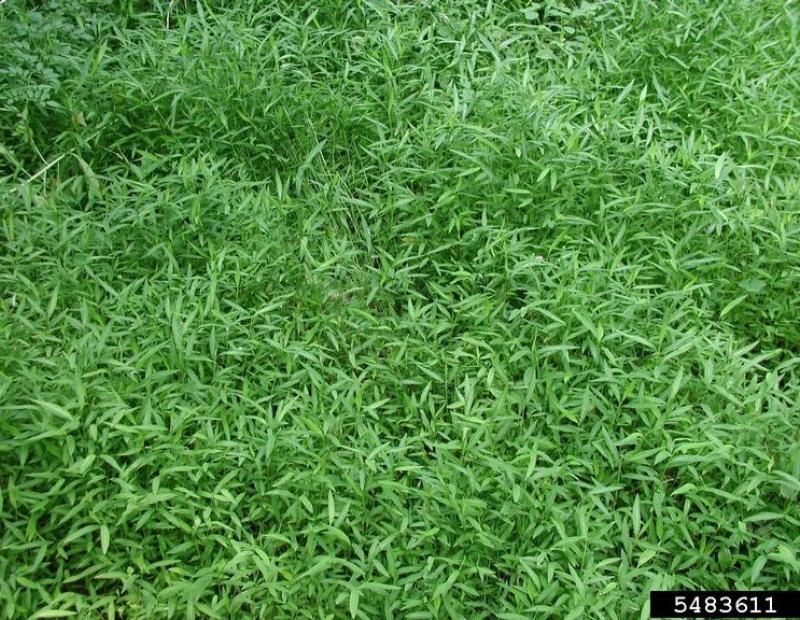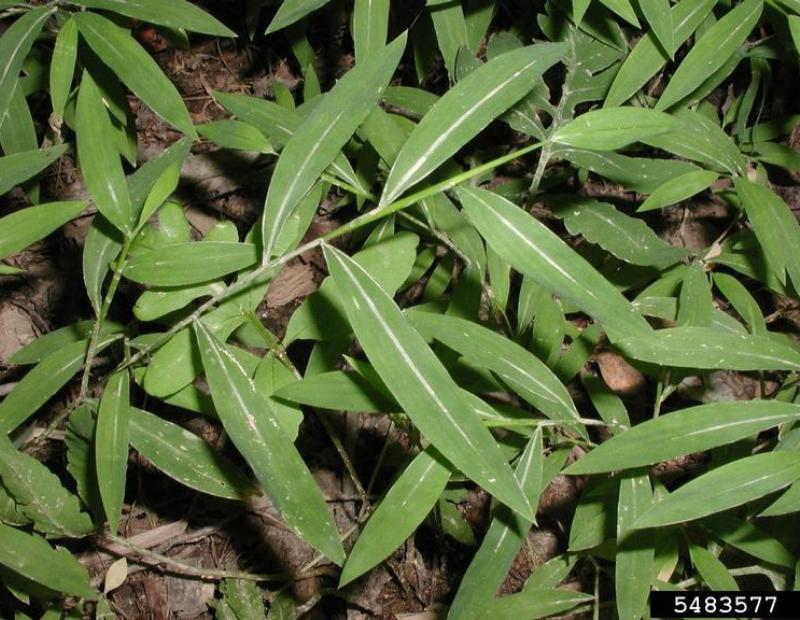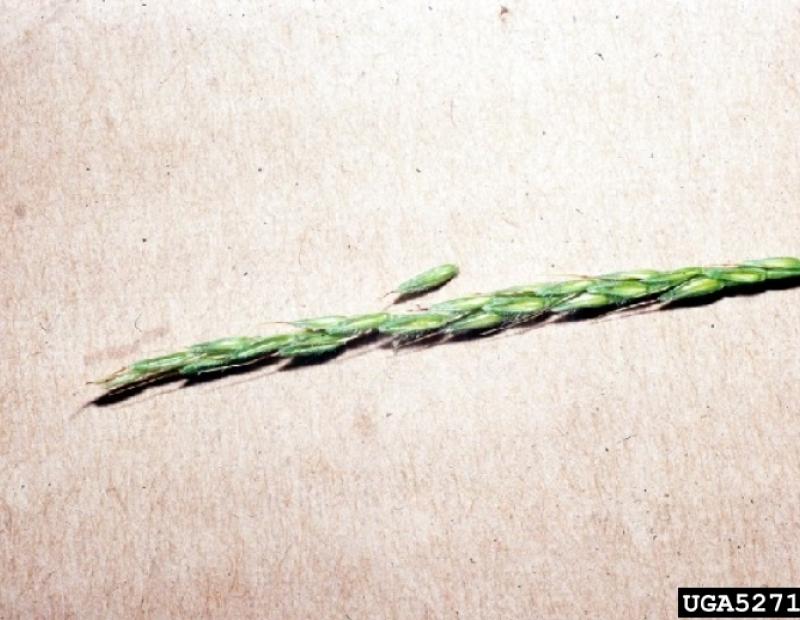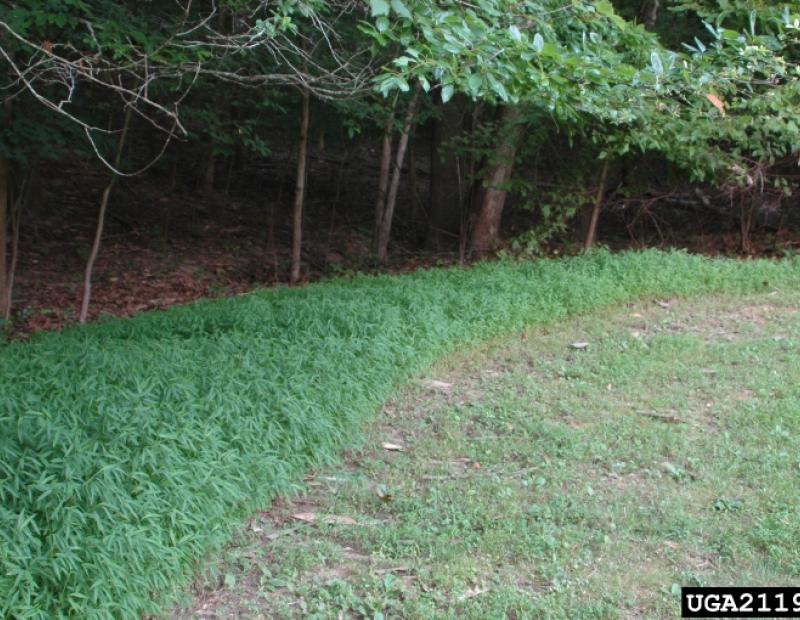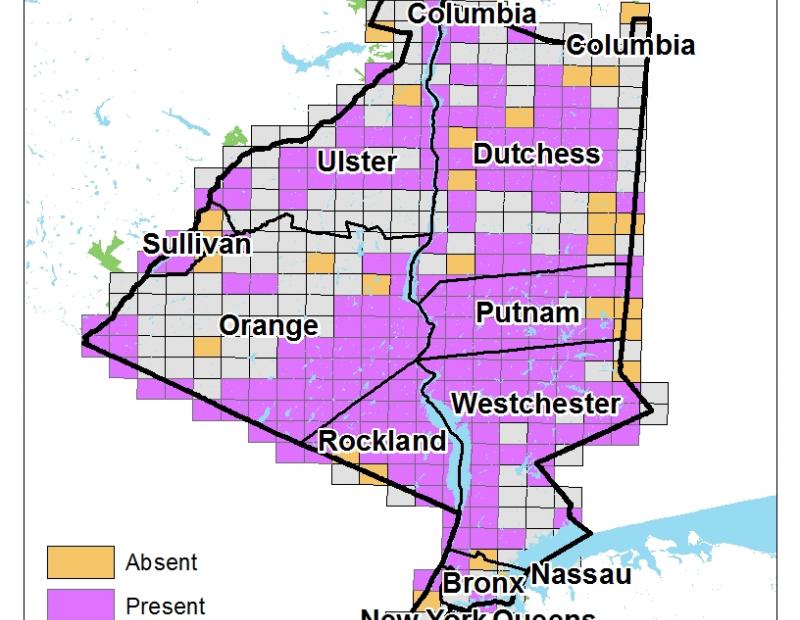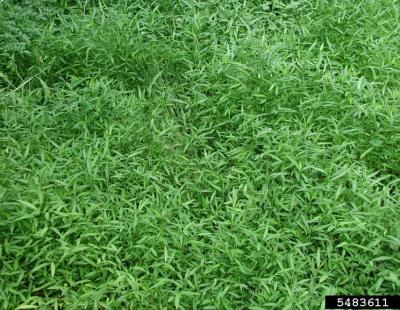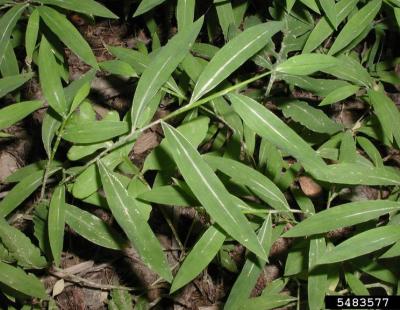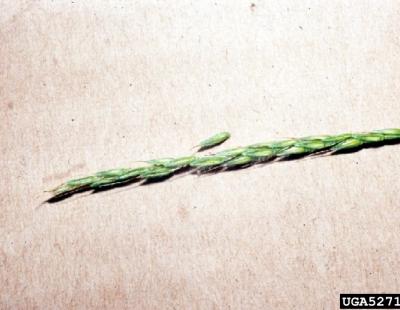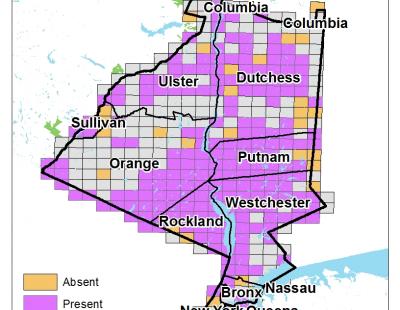Vertical Tabs
An annual grass that grows to 1 m or more (but often shorter), often forming dense stands. Leaves with smooth edges, often with a glossy, light midrib, spaced along the stem. Stems are thin, tend to sprawl, and may branch at the base into several stems. Roots are shallow and pull out very easily; lower stem nodes may produce stilt roots, hence the common name. Dead grass often persists in winter as a conspicuous thatch layer.
The presence of stiltgrass changes forest soils, resulting in reduced leaf litter and organic matter in soil, higher pH and magnesium, and in some cases higher available phosphorous and calcium.5,6 As stiltgrass cover increases, native plant cover and diversity are often reduced,2,5 although this effect is likely due to a combination of stiltgrass, deer herbivory, and nonnative earthworm abundance.7 Stiltgrass excludes seedlings of woody species in eastern forests, potentially altering forest development.2 Stiltgrass-invaded understories tend to have increased aboveground biomass, which in turn can lead to increased abundance and diversity of arthropods8 (although sometimes these measures decline6). However, arthropod evenness tends to be reduced, as herbivores that can eat stiltgrass are favored.8 In sites with low available nitrogen and high stiltgrass biomass, carbon cycling can accelerate and result in significant declines in microbial biomass and soil organic carbon (impacting forest carbon storage on a large scale).9,10 Stiltgrass seems to be unpalatable to deer. The avoidance of stiltgrass and preferential foraging by deer on other plants favors the spread of stiltgrass by reducing plant competition. Stiltgrass cover was lower where deer were excluded;4 excluding deer and removing stiltgrass increased survival of oak seedlings.11 The replacement of forest understory shrubs and trees with stiltgrass may help explain declines in bird species that nest on the ground or in the understory or midstory.2 In a southeastern forest, American toad metamorph survival was reduced in stiltgrass areas, likely due to the increased density of predatory wolf spiders.12 The presence of stiltgrass can affect controlled burns in fire-adapted forests, raising maximum temperatures, reducing germination of native species, and stimulating subsequent growth of stiltgrass.13 However, this relationship varies with soil moisture, and fire in drier sites may not promote stiltgrass.14
In a Westchester forest preserve with overabundant white-tailed deer and a species-impoverished understory layer, stiltgrass provided favorable habitat for three native amphibian species.15 It may also provide important cover for white-footed mouse.2 Native insects, including grasshoppers, katydids, crickets, and bugs graze on stiltgrass, but are not known to significantly deplete a local population. Stiltgrass seems to be avoided by cattle, goats, and horses,2 but is grazed by sheep.16
Manual or Mechanical Control
This page focuses on manual best management practices only. Please contact invasives@nynjtc.org with specific questions on chemical or biological control options.
- Reduce or exclude deer populations. This will aid recovery of native plants, may reduce populations of nonnative earthworms,4 and as a result slow population growth of stiltgrass.
- Minimize soil and canopy disturbance: this will slow spread and lower chances of reintroduction.
- For smaller areas, hand-pull plants once a year in the fall before seed set (but after seed development of most other plants).17,19,20 Hand-pulling is the best method for allowing native woody plant regeneration17 and restoring a diverse community of native plants.21 Handpulling was much more effective in fall (prior to seed set)17 than in June or July.20,22 Avoid hand-pulling multiple times in a season; this disturbs soil more and increases recruitment of other invasive plants.19
- For larger areas, mow (or scythe, weed-eat, or pasture sheep) once a year any time after July 1, for multiple consecutive years.20,23 To allow native plant recovery, mow annually for 3-4 years then take a year off.23 Mowing multiple times in a season may stimulate stiltgrass seed production.
- Alternatively, use a 400K BTU propane torch to kill plants once a year in June or July.22 On days following or during rains (when litter is thoroughly wet), apply flame treatment to plants until leaves are severely wilted but without igniting litter. This treatment was very effective, although much more time-consuming than weed-eating. A combined treatment may be more efficient, where plants are first cut in August, and then any remaining (green) plants spot-treated with the propane torch 2 or 3 weeks later.22 (Torching must be done with great care to avoid starting vegetation fires. A permit might be needed.)
- Repeat annual pulling, cutting, or flame treatment for at least 3 years.19,20 Cover may actually increase after the first year of treatment, but in one experiment, after 3 years of preventing seed production by mowing or hand-pulling, cover was reduced by 82% and the seed bank by 93%.19 At the same time, native herb cover increased by 325%, and the native herb seed bank and species richness also increased.19
- For large invaded areas, an alternative approach is to plant tree seedlings (species appropriate to the forest type). In addition to aiding forest regeneration, the more dense shade created by a subcanopy layer could help suppress stiltgrass. Survival of two-year-old seedlings planted at 0.5-m spacing in a dense stiltgrass understory was unaffected by the stiltgrass. However, if overabundant deer are a problem, seedlings may need protection to survive.
Management Goals
- Prevent establishment of new populations by annual monitoring and removal.
- Eradicate small patches by preventing seed production until seed bank is depleted, usually 25 years.
- Limit spread and reduce density of large invasions by limiting seed production. Target patches along roadsides and trails as these populations provide seed for forest invasions.2 Management projects are effort-intensive and should be chosen thoughtfully.
REFERENCES
- Alabama Cooperative Extension. Field Guide to the Identification of Japanese Stiltgrass.
http://www.aces.edu/pubs/docs/A/ANR-1457/ANR-1457-low.pdf - Fryer, J.L. 2011. Microstegium vimineum. In: Fire Effects Information System. U.S. Department of Agriculture, Forest Service, Rocky Mountain Research Station, Fire Sciences Laboratory. http://www.fs.fed.us/database/feis/ [Accessed 21 July, 2016].
- Warren, R.J. II, V. Bahn, and M.A. Bradford. 2012. The interaction between propagule pressure, habitat suitability and density-dependent reproduction in species invasion. Oikos 121:874-881.
- Dávalos, A., V. Nuzzo, and B. Blossey. 2015. Single and interactive effects of deer and earthworms on non-native plants. Forest Ecology and Management 351:28-35.
- Tekiela, D.R., and J.N. Barney. 2015. System-level changes following invasion caused by disruption of functional relationships among plant and soil properties. Ecosphere 6:294.
- McGrath, D.A., and M.A. Binkley. 2009. Microstegium vimineum invasion changes soil chemistry and microarthropod communities in Cumberland Plateau forests. Southeastern Naturalist 8:141-156.
- Nuzzo, V., J.C. Maerz, and B. Blossey. 2009. Earthworm invasion as the driving force behind plant invasion and community change in northeastern North American forests. Conservation Biology 23(4):966-974.
- Tang, Y., R.J. Warren II, T.D. Kramer, and M.A. Bradford. 2012. Plant invasion impacts on arthropod abundance, diversity and feeding consistent across environmental and geographic gradients. Biological Invasions 14:26252637.
- Craig, M.E., S.M. Pearson, and J.M. Fraterrigo. 2015. Grass invasion effects on forest soil carbon depend on landscapelevel land use patterns. Ecology 96:2265-2279.
- Kramer, T.D., R.J. Warren II, Y. Tang, and M.A. Bradford. 2012. Grass invasions across a regional gradient are associated with declines in belowground carbon pools. Ecosystems 15:1271-1282.
- Johnson, D.J., S.L. Flory, A. Shelton, C. Huebner, and K. Clay. 2015. Interactive effects of a non-native invasive grass Microstegium vimineum and herbivore exclusion on experimental tree regeneration under differing forest management. Journal of Applied Ecology 52:210-219.
- DeVore, J.L., and J.C. Maerz. 2014. Grass invasion increases top-down pressure on an amphibian via structurally mediated effects on an intraguild predator. Ecology 95:1724-1730.
- Emery, S.M., J. Uwimbabazi, and S. Luke Flory. 2011. Fire intensity effects on seed germination of native and invasive Eastern deciduous forest understory plants. Forest Ecology and Management 261:1401-1408.
- Wagner, S.A., and J.M. Fraterrigo. 2015. Positive feedbacks between fire and non-native grass invasion in temperate deciduous forests. Forest Ecology and Management 354:170-176.
- Nagy, C., S. Aschen, R. Christie, and M. Weckel. 2011. Japanese stilt grass (Microstegium vimineum), a nonnative invasive grass, provides alternative habitat for native frogs in a suburban forest. Urban Habitats 6.
- Tesauro, J. 2001. Restoring wetland habitats with cows and other livestock: A prescribed grazing program to conserve bog turtle habitat in New Jersey. Conservation Biology in Practice 2:26-30.
- Gibson, D.J., G. Spyreas, and J. Benedict. 2002. Life history of Microstegium vimineum (Poaceae), an invasive grass in southern Illinois. Journal of the Torrey Botanical Society 129(3):207-219.
- Warren, R.J. II, V. Bahn, and M.A. Bradford. 2013. Decoupling litter barrier and soil moisture influences on the establishment of an invasive grass. Plant Soil 367:339-346.
- Judge, C.A., J.C. Neal, and T.H. Shear. 2008. Japanese stiltgrass (Microstegium vimineum) management for restoration of native plant communities. Invasive Plant Science and Management 1(2):111-119.
- Flory, S.L., and J. Lewis. Nonchemical methods for managing Japanese stiltgrass (Microstegium vimineum). Invasive Plant Science and Management 2:301-308.
- Flory, S.L., and K. Clay. 2009. Invasive plant removal method determines native plant community responses. Journal of Applied Ecology 46:434-442.
- Ward, J.S., and T.L. Mervosh. 2012. Nonchemical and herbicide treatments for management of Japanese stiltgrass (Microstegium vimineum). Invasive Plant Science and Management 5:9-19.
- Shelton, A. 2012. Mowing any time after midsummer can manage Japanese stiltgrass. Invasive Plant Science and Management 5:209-216.
- Beasley, R.R., and B.C. McCarthy. 2009. Effects of Microstegium vimineum (Trin.) A. Camus (Japanese stiltgrass) on native hardwood survival and growth: Implications for restoration. Natural Areas Journal 31:246-255.
- Stricker, K.B., P.F. Harmon, E.M. Goss, K. Clay, and S.L. Flory. 2016. Emergence and accumulation of novel pathogens suppress an invasive species. Ecology Letters 19:469-477.
- Belote, R.T., J.F. Weltzin, and R.J. Norby. 2003. Response of an understory plant community to elevated [CO2] depends on differential responses of dominant invasive species and is mediated by soil water availability. New Phytologist 16:827-835.
- Ziska, L.H., M.B. Tomecek, M. Valerio, and J.P. Thompson. 2015. Evidence for recent evolution in an invasive species, Microstegium vimineum, Japanese stiltgrass. Weed Research 55:260-267.

